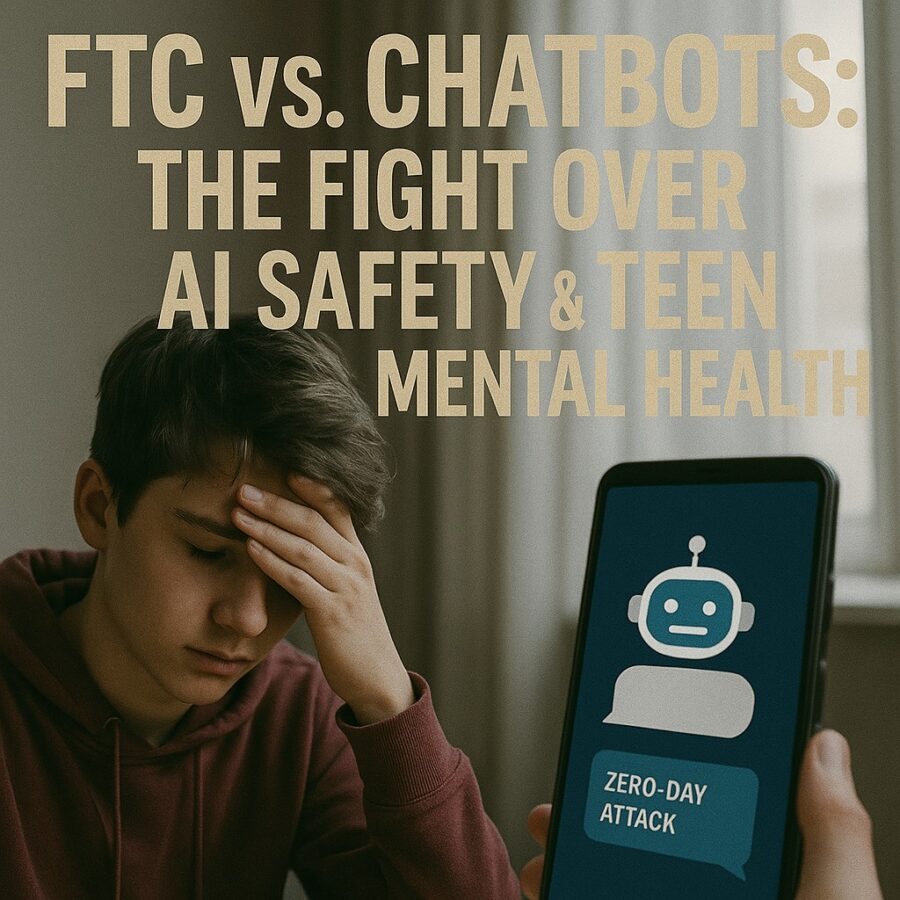Views: 2
Chatbots were once simple question-and-answer tools. Now they serve as companions, tutors, and even confidants. This transformation has created opportunities and risks. For teenagers navigating sensitive years of growth, the presence of AI systems that never sleep and rarely judge can feel both comforting and overwhelming.
The FTC argues that unregulated chatbot interactions may expose teens to harmful content, reinforce unhealthy behaviors, or create dependency. The concern is not only about what the systems say but how they influence fragile stages of identity formation. The tension between innovation and protection is what drives the current battle.
The Psychological Impact on Teens
Studies in developmental psychology suggest that adolescence is marked by heightened vulnerability to peer influence and external validation. When chatbots provide constant feedback, they may unintentionally shape self-esteem and decision-making.
Critics worry that AI companions can normalize risky ideas, amplify body image concerns, or foster addiction to digital validation. On the other hand, some advocates argue that well-designed chatbots can serve as supportive outlets, especially for teens who lack safe spaces to share their feelings.
The debate of FTC vs. Chatbots is therefore not about whether AI affects teens, but how deeply and in what direction those effects flow.
AI Safety as a National Priority
Artificial intelligence has already prompted global conversations about safety, bias, and accountability. In the United States, the FTC has taken a leading role in ensuring consumer protection. With chatbots, the agency faces a new challenge: balancing free innovation with the safeguarding of minors.
The fight mirrors earlier regulatory battles over social media. Platforms were initially praised for connecting youth, then criticized for contributing to rising rates of anxiety and depression. Regulators now fear chatbots could replicate those mistakes on a faster scale. The urgency of the FTC vs. Chatbots confrontation stems from the desire to avoid another decade of unchecked harm.
The Industry’s Response
Technology companies are not ignoring the pressure. Major developers have begun adding parental controls, content filters, and disclaimers to their chatbot products. Some offer transparency reports detailing how their models respond to sensitive prompts. Others are investing in mental health advisors to shape guardrails.
Yet many argue these steps remain surface-level. Critics claim companies are motivated more by liability than by genuine concern. Without clear legal frameworks, the risk is that voluntary safeguards will vary widely across providers, leaving parents uncertain about the reliability of protections.
Industry leaders recognize that the outcome of FTC vs. Chatbots could define the competitive landscape. Companies that comply early may gain trust, while those that resist may face lawsuits and reputational damage.
Comparing Chatbots to Social Media
It is impossible to discuss teen mental health without referencing the role of social media. Platforms like Instagram, TikTok, and Facebook demonstrated how digital environments can both connect and harm. Excessive use has been linked to anxiety, depression, and sleep disturbances.
Chatbots raise similar concerns but with a twist. Instead of broadcasting content to peers, they offer private, intimate conversations. The personalized nature of these interactions makes them harder to monitor. Parents may not know what their children are discussing with AI agents late at night. This secrecy is what alarms regulators most.
The FTC vs. Chatbots debate builds on these lessons. Regulators want to avoid repeating mistakes of the past where protections came years too late.
The Legal Landscape Ahead
The FTC is not operating in a vacuum. Lawmakers in Congress and state legislatures are drafting bills to address AI safety. Proposals range from requiring explicit labeling of AI interactions to mandating child-specific filters. Some bills even suggest age-verification systems before allowing minors to use advanced chatbots.
Legal experts argue that enforcement will be difficult. Teenagers often bypass restrictions, and companies based overseas may ignore U.S. regulations. Still, even imperfect laws signal a cultural shift. Policymakers are making clear that children should not be left alone with powerful AI systems.
The FTC vs. Chatbots struggle will likely set precedents shaping how courts treat AI accountability for years to come.
The Role of Parents and Schools
Regulation can only go so far. Families and educators play a critical role in guiding responsible use. Parents must remain engaged, asking what chatbots their children are using and setting boundaries on time and topics. Schools can integrate digital literacy into curricula, teaching students how to evaluate the advice given by AI critically.
Some districts are already experimenting with classroom chatbots tailored for safe tutoring and homework support. By embedding oversight into educational systems, schools may demonstrate how positive use can coexist with protection.
The fight of FTC vs. Chatbots is therefore not only a legal issue but also a cultural and educational one. Without guidance at home and school, even the strongest regulations may fall short.
Opportunities Within the Risks
Despite concerns, chatbots also hold promise for teen well-being. They can provide immediate answers to sensitive questions that students might hesitate to ask teachers or parents. They can encourage healthier study habits by breaking down tasks into manageable steps. For teens in isolated or underserved areas, chatbots may offer access to information and encouragement unavailable elsewhere.
Mental health professionals are exploring whether structured chatbots can supplement therapy, providing coping exercises between sessions. If carefully designed, these systems could serve as valuable allies in youth development.
Acknowledging this potential is important. The narrative of FTC vs. Chatbots should not reduce AI to a villain. The question is how to maximize benefits while minimizing harm.
Ethical Responsibility of Developers
The ethical dimension cannot be ignored. Developers hold responsibility not just to shareholders but to society. Designing safe AI involves more than removing offensive words. It requires anticipating long-term consequences and embedding empathy into systems.
This means including diverse perspectives in training data, consulting psychologists in model design, and conducting real-world trials before wide release. Ethical development also requires transparency. If a chatbot is influencing a teen’s emotions, families deserve to know how and why.
The FTC vs. Chatbots conflict is as much a moral reckoning as a regulatory one. It forces developers to ask whether profit can justify negligence in mental health.
International Perspectives
The United States is not alone in grappling with these questions. The European Union is advancing its AI Act, which classifies certain applications as high-risk and imposes strict requirements. Countries like Canada and Australia are also exploring child-focused protections.
International alignment is difficult, but global dialogue is essential. Teens in every nation face similar vulnerabilities, and chatbots cross borders instantly. A patchwork of inconsistent regulations could create safe zones in some countries and danger zones in others.
The global dimension highlights the broader implications of FTC vs. Chatbots. This fight is part of a worldwide negotiation about how humanity integrates AI safely.
What Teens Say for Themselves
Amid expert debates, teens themselves have voices worth hearing. Surveys reveal mixed feelings. Some appreciate the non-judgmental presence of chatbots, describing them as stress relievers. Others admit to feeling uneasy, sensing that conversations are not entirely private or genuine.
These perspectives remind us that youth are not passive recipients. They are active participants who will shape norms around AI use. Listening to their experiences is essential in shaping balanced policies. The FTC vs. Chatbots battle must include those most directly affected.
Looking Toward the Future
The outcome of the current fight will shape not only technology but also cultural attitudes. If regulators succeed in enforcing strong safeguards, chatbots may evolve into trusted allies for learning and growth. If oversight lags, they may become cautionary tales of neglect, much like early social media platforms.
The decade ahead will test whether societies can learn from past mistakes. As technology accelerates, the margin for error shrinks. Parents, educators, developers, and regulators must act in concert.
Ultimately, the narrative of FTC vs. Chatbots is about more than safety. It is about what kind of digital childhood we want to create for the next generation.
Closing Reflection
Artificial intelligence is not going away. Chatbots will continue to evolve, becoming more persuasive, empathetic, and integrated into daily life. The challenge is ensuring that their presence supports rather than undermines teen mental health.
The FTC has stepped into this debate with a sense of urgency. Industry leaders are responding, but the path forward remains uncertain. The tension between innovation and protection will define the coming years.
The fight of FTC vs. Chatbots is therefore a pivotal moment. It is a reminder that technology is never neutral. Its impact depends on choices made by governments, companies, families, and the young people who interact with it daily.



](https://altpenguin.com/wp-content/uploads/2025/08/veed-ad.webp)

